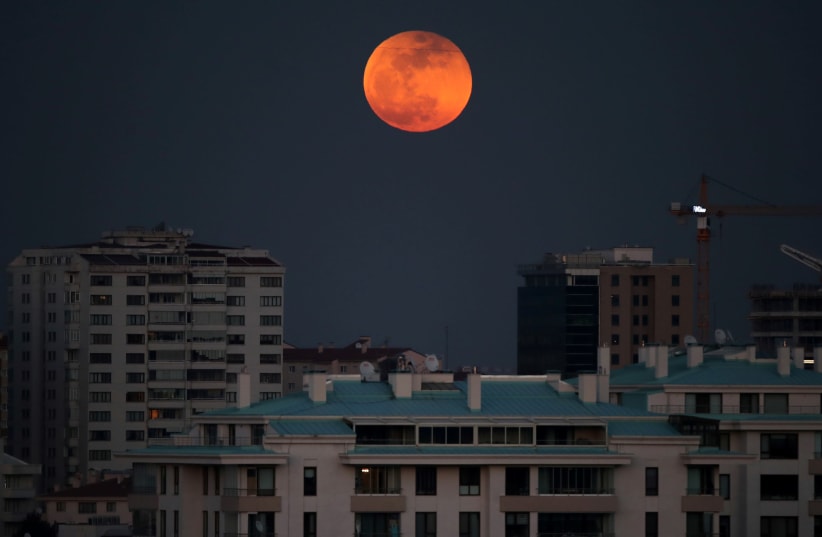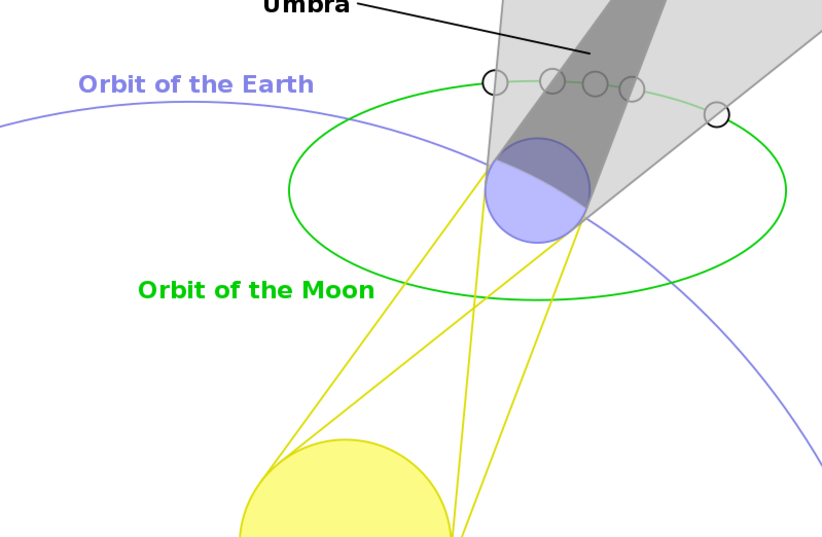Lunar eclipses are one of the most visually awe-inspiring celestial events, and on November 19 many people across the world will be able to witness a partial one. Only two weeks later, on December 4, there will be a total solar eclipse.
Want to know what happens during a lunar eclipse, what you should expect, and when and where you can view one?
Here’s everything you need to know about lunar eclipses.
When is the next lunar eclipse?
The next lunar eclipse – a partial one – will take place late at night on November 18 and early November 19, at 06:02 UTC -- However Israelis will be disappointed to learn that the partial eclipse will be unavailable.
The Jerusalem Post’s American readers are luckier, and will be able to view the Earth’s shadow partially passing over the Moon on the night of November 18. If you live in New York, the Moon will pass through the Earth’s penumbra, the area in which the sun’s light is obscured, at 1:02 am EST. The partial eclipse, when the moon will partially pass through the Earth’s umbra -- where the sun’s light is totally blocked -- will begin at 2:18 a.m., reach its zenith at 4:02 a.m. and end at 5:47 a.m.
Readers in Los Angeles will be able to see the partial lunar eclipse at more reasonable viewing times. The prenumbral eclipse begins in the LA area on November 18 at 10:02 p.m. and the partial eclipse will begin at 11:18 p.m. At 1:02 a.m. the moon will be the furthest into the Earth’s shadow. The partial eclipse will end at 2:47 am on November 19 and the prenumbral eclipse will end almost two hours later, at 4:03 am.
Where is the 2021 lunar eclipse visible?
The November 2021 partial lunar eclipse won’t be visible from Israel, the rest of the Middle East, most of Africa, Eastern Europe and central Asia. Those that live in Western Europe, Eastern Asia, North and South America, and Australia will be able to see the eclipse, with varying degrees of visibility and time availability.
What causes a lunar eclipse?
A lunar eclipse occurs when the Sun, Earth, and Moon are aligned, with the Earth blocking the sunlight from reaching its satellite. The Earth casts a shadow, called an umbra, and because the planet is spherical and the atmosphere refracts light, there is also a partial shadow called a preumbra.
As the Moon passes into the Earth's shadow, a spherical black disc will appear to move across its surface. Not all eclipses fully cover the Moon in shadow.
There are three types of eclipses: total, partial and preumbral. In preumbral eclipses, the Moon passes in the partial shade of the Earth, and will appear darker. In partial eclipses, the moon partially passes into the Earth’s umbra, and will appear in various crescent shapes as the disc shadow passes along its surface, but will never fully cover it. In a total lunar eclipse, the moon fully enters the umbra, but despite being cast in shadow, will still be visible to certain degrees.
There is also a very rare kind of total lunar eclipses called a central total eclipse, in which the moon enters the antisolar point, the very center of the Earth’s umbra.
During all eclipses the Moon will change in hue to a dark red or bronze color, the exact color depending on atmospheric conditions on Earth. A total eclipse is sometimes called a “blood moon” due to the altered red coloration, which has lent to perceptions in the past of the event being supernatural in nature.
Lunar eclipses occur during full moons, when the Moon is aligned with the Earth and Sun and fully illuminated by sunlight. Not every full moon is a lunar eclipse because the moon orbits the Earth at a different angle than the Earth and Moon orbit the Sun.
Not all eclipses last the same amount of time, depending on how far into the umbra the Moon enters. How near the Moon is to the Earth also impacts the eclipse’s duration. The farther away the Moon is from Earth, the slower the orbit, and therefore the longer the eclipse.
How often do lunar eclipses occur?
Lunar eclipses occur two to five times a year, but total lunar eclipses occur
about twice every three years. The last one was on May 25 and 26, but was largely only fully viewable in Australia and the Pacific Ocean. The next lunar eclipse after the partial eclipse on November 19 will be on May 16, 2022. This will be a total lunar eclipse -- but once again, Israelis will be unable to view it. It will only be visible in Africa, Europe, and North and South America.
NASA catalogues lunar and solar eclipses, having recorded them as far back as 1901, and has calculated their occurrences up until 2100. From 2000 BCE until 3000 CE, there will have been 12,064 eclipses.
What is the difference between a lunar and solar eclipse?
While a lunar eclipse is the Earth blocking the light of the Sun, a solar eclipse is when the Moon passes directly between the Sun and the Earth. Much like a lunar eclipse, a black disk slowly eats away at the Sun as the Moon passes between the two bodies.
Solar eclipses can also be partial or total. When the Sun is covered by the Moon, it is accompanied by darkness. The Moon appears dark with only a halo of light around it. In an annular solar eclipse, the Moon sits at the center of the sun, and the halo is much wider. Looking at a solar eclipse directly can damage one’s vision, so observers should wear eye protection. A lunar eclipse, on the other hand, is completely safe to view without protection.
Solar and lunar eclipses usually occur within a few weeks of one another. This happens because for both types of eclipses, the bodies must be aligned. As the Moon continues its orbit, it rotates to the other side of the Earth allowing for the other type of eclipse to occur.
The last solar eclipse was an annular one, and occurred on June 10, 2021. The next solar eclipse will be December 4, just two weeks after the November lunar eclipse, and will be total. Unfortunately, very few people will be able to observe the event, as the full eclipse will only be visible from Antarctica.

